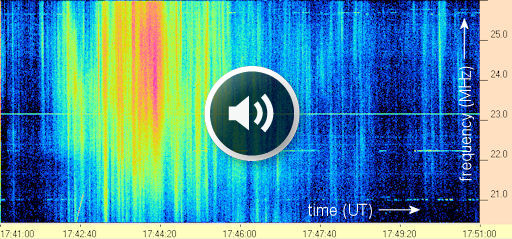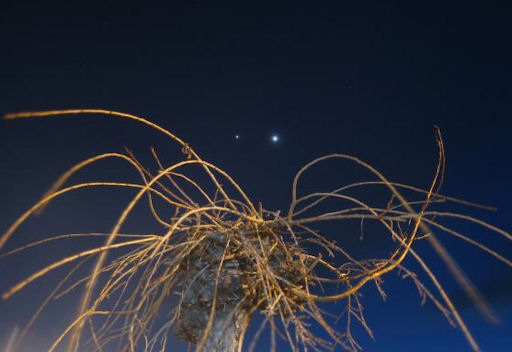Don't just watch shooting stars. Wear them! Authentic meteorite jewelry for Valentine's Day is now available in the SpaceWeather Store. | | |
CME IMPACT AND GEOMAGNETIC STORM: A moderate G2-class geomagnetic storm, caused by the arrival of a CME on March 12th at ~0930 UT is subsiding. The CME's impact caused ground currents in Norway, and strongly compressed Earth's magnetosphere, possibly exposing geosynchronous satellites to solar wind plasma. At the same time, photographic Southern Lights were recorded over New Zealand and Tasmania. High-latitude sky watchers should remain alert for auroras. Aurora alerts: text, phone.
WEEKEND SOLAR FLARE: Sunspot AR1429 erupted again over the weekend. On Saturday, March 10th, it produced a powerful M8-class flare that almost crossed the threshold into X-territory. During the flare, New Mexico amateur astronomer Thomas Ashcraft recorded a series of radio bursts at 21 and 28 MHz:

Dynamic spectrum courtesy Wes Greenman, Alachua County, Florida
The roaring sounds you just heard are caused by shock waves plowing through the sun's atmosphere in the aftermath of the explosion. "There is incredible complexity in the waveforms," notes Ashcraft. "This is a recording of one of the most turbulent events in all of Nature!"
more data: from the Charlie Bates Solar Astronomy Project in Atlanta, Georgia; from Eric Todd of Philadelphia, PA
SUNSET PLANETS: This is a great week to admire the sunset. Venus and Jupiter are side-by-side only 3o apart in the western sky, beaming through the twilight as soon as the sun goes down. "We have a wild tree in our front yard just begging for a set of eyes," says photographer Jeff Brown of Selah, Washington. "Jupiter and Venus worked perfectly." (continued below)

The two bright planets seem to inspire photographic creativity. In Wiltshire, England, Richard Fleet measured their angular separation using a pair of cat's ears, while photographer Claus Vogel of Ottawa, Ontario, tried his hand at planet painting.
Let the planets be your muse, and submit your images here.
more images: from Chad Blakley of Abisko National Park, Sweden; from Göran Strand of Frösön, Sweden; from Gary A. Becker of Coopersburg, PA; from Andrew Dianetti of Paris, France; from Andrew Hoggins of Knowlton Dorset UK; from P-M Hedén of Stockholm, Sweden; from Barbara L. Schumacher of Vista, California.
February 2012 Aurora Gallery
[previous Februaries: 2011, 2010, 2009, 2008, 2007, 2006, 2004, 2003, 2002]

